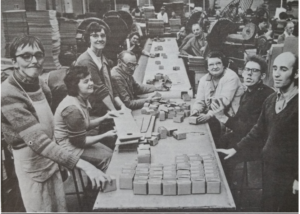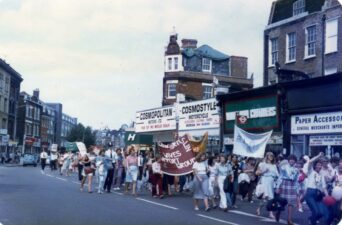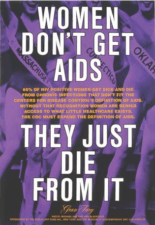Remploy was created by the British Government towards the end of the Second World War to provide sheltered employment – a term used to describe workplaces dedicated to employing disabled people in an environment ‘sheltered’ from the competitive pressures of the open employment market. Traditionally, sheltered employment had been operated by charitable groups, in individual or small-scale networks of workshops. Remploy was created as a genuinely pioneering attempt to provide a national scheme of sheltered employment, financially backed by the Treasury, and thereby positioned to provide meaningful and productive work for all those who wanted to work but were considered too ‘severely disabled’ to be able to gain and keep employment.
The traditional image of Remploy in the post-war period is that it catered overwhelming for men. Indeed, this was largely the case, with a clear focus on providing industrial and manufacturing work for so-called family ‘breadwinners’. At the opening of the first Remploy factories in 1946, out of 164 disabled workers, only 4 were women. By 1950, this had risen to 158 women, but this remained a tiny proportion, with some 4,781 men then working for Remploy across 90 factories. Over the course of its history, however, and reflecting wider employment trends, Remploy saw a steady and continuous increase in the numbers of disabled women workers it employed. At the start of the 1980s, the decade when the company reached its height, more than 20 per cent of the disabled employees were women – a minority, therefore, but a significant one.
Each Remploy factory could operate quite differently, reflecting the local nature of much of the available production and personnel. The experiences the employees had of working depended a great deal on the nature of their local Remploy factory. As was common in industry more widely, in theory, there remained the notion of certain work being particularly suitable either for men or women. This meant certain trades undertaken by the company were considered primarily suited to men (engineering, furniture manufacture), or women (packaging, leather and textiles, knitwear). However, such segregation was never close to being absolute. There were always more men than women working in every trade group, including those associated with the idea of ‘women’s work’. There were also numerous instances where women worked in the traditional ‘male trades’. Such was the case at the Birmingham Remploy Factory, part of the Engineering Group, where a quarter of the workforce in 1964 were women.
The company referred to this as the ‘gender mix’ of individual factories, and it varied widely from place-to-place and over time. While there were plenty of factories over the years which only employed disabled men, the majority of factories did include some women workers as well. In 1953, for example, the St Helens factory employed 48 disabled workers, of whom 16 were women. The Aberdeen factory in 1956 had 36 employees of whom 13 were women. In 1975 the Cowdenbeath factory in Scotland employed 90 disabled people, of whom half were women.
The evidence suggests that in those instances where men and women worked in the same Remploy factory, there was little segregation within the factory itself. Working together on the production floor represented a normal state of affairs. This was also the case for much of the ‘social life’ of the factory, with disabled men and women attending events, parties, dances, outings and holidays provided by the company together. A testament to the socialising which took place was the frequency of marriages between disabled employees who had often first met ‘on the factory floor’ reported in the company newsletter ‘Remploy News’.
While it is the case that Remploy catered primarily to disabled men, there was a significant minority of disabled women who worked within these factories, and it is important that this is not forgotten. With much determined by the nature of their local factory, these women would have had their own unique experiences of Remploy and sheltered employment.
Dr Andy Holroyde completed his PhD at the University of Huddersfield, as part of the Heritage Consortium, in 2019. Funded by the Arts and Humanities Research Council, his project explored Sheltered Employment and Disability in the British Welfare State during the period 1944-1979. Currently a Honorary Research Fellow at the Mile End Institute at Queen Mary University of London, his primary research interests continue to be the development of sheltered employment for disabled people and the notion of inclusive economies.

Images courtesy of Remploy


